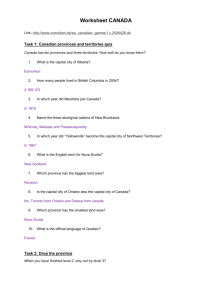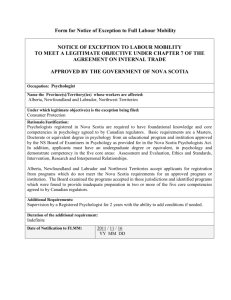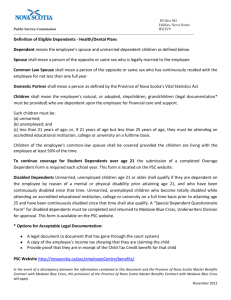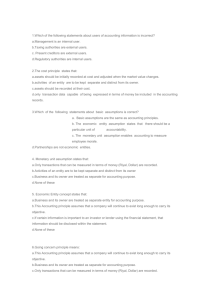23.1 Special Purpose Funds - Government of Nova Scotia
advertisement
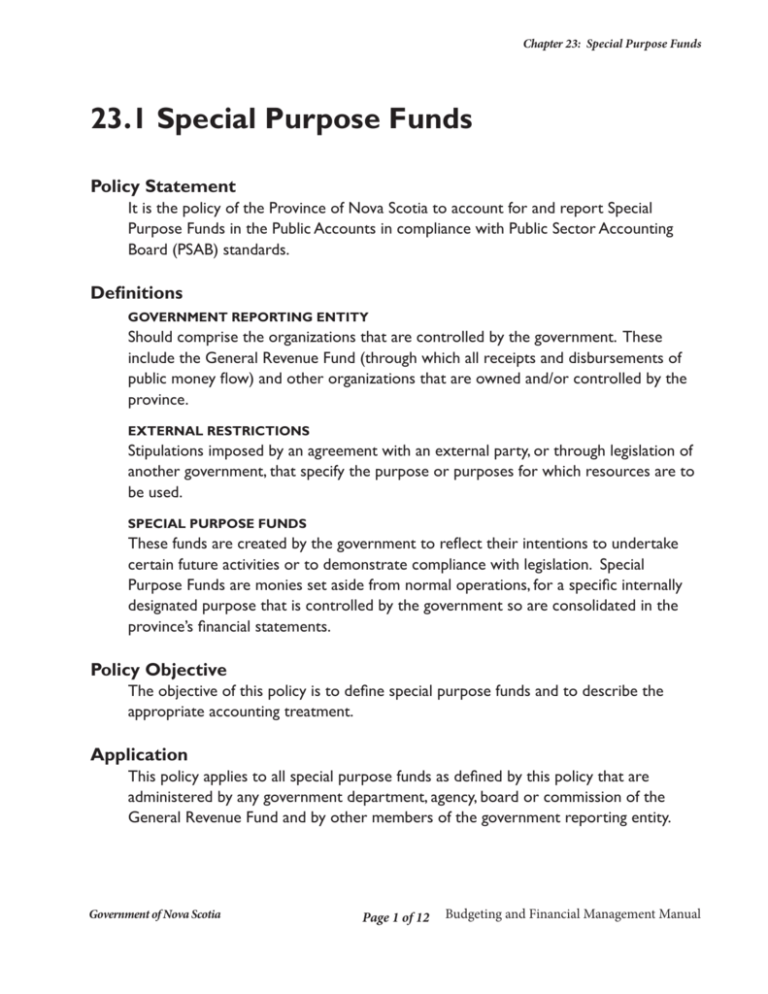
Chapter 23: Special Purpose Funds 23.1 Special Purpose Funds 23.1 Special Purpose Funds Policy Statement It is the policy of the Province of Nova Scotia to account for and report Special Purpose Funds in the Public Accounts in compliance with Public Sector Accounting Board (PSAB) standards. Definitions GOVERNMENT REPORTING ENTITY Should comprise the organizations that are controlled by the government. These include the General Revenue Fund (through which all receipts and disbursements of public money flow) and other organizations that are owned and/or controlled by the province. EXTERNAL RESTRICTIONS Stipulations imposed by an agreement with an external party, or through legislation of another government, that specify the purpose or purposes for which resources are to be used. SPECIAL PURPOSE FUNDS These funds are created by the government to reflect their intentions to undertake certain future activities or to demonstrate compliance with legislation. Special Purpose Funds are monies set aside from normal operations, for a specific internally designated purpose that is controlled by the government so are consolidated in the province’s financial statements. Policy Objective The objective of this policy is to define special purpose funds and to describe the appropriate accounting treatment. Application This policy applies to all special purpose funds as defined by this policy that are administered by any government department, agency, board or commission of the General Revenue Fund and by other members of the government reporting entity. Government of Nova Scotia Page 1 of 12 Budgeting and Financial Management Manual Chapter 23: Special Purpose Funds 23.1 Special Purpose Funds Policy Directives PROCESS AND PROCEDURES Special Purpose Fund deposits reside with the Department of Finance and are managed through Liability Management and Treasury Services (LMTS). Each fund has its own bank account and resulting administrative procedures connected to it. The administrative costs related to Special Purpose Funds are significant. In many cases, the purpose of the fund can be better achieved as a departmental initiative whereby the process surrounding administration, budgeting and financial reporting are reduced. Special Purpose Funds are created pursuant to Sections 2 and 13 of the Finance Act. The Finance Act provided both the authority for the creation of the fund as well as the fund’s spending authority. 2 (ac) “special purpose fund” means public money designated by the Minister as a special purpose fund in accordance with the Finance Act. 13 (1) All money received by the Minister must be deposited to the credit of the Minister in the General Revenue Fund or the appropriate trust fund. A department must demonstrate the need for and purpose of a Special Purpose Fund in a Report and Recommendation submission to Executive Council. Once reviewed, a successful request will be forwarded to Executive Council for consideration. The Department of Finance often provides advice to parties involved when necessary. Approval is granted by OIC to create the Fund. Once created, the department is responsible to provide Liability Management and Treasury Services with the OIC and a properly completed signing authority form (Appendix 23-B and 23-C). At that point, a bank account for the Fund will be opened. Now that the province produces consolidated financial reports, the need for Special Purpose Funds is much more limited. The transfer of monies between departmental budgets and a Special Purpose Fund will not impact the overall operating results on a consolidated basis. It is no longer a possible method to carry over budget dollars to a future year. When the need for any Special Purpose Fund has passed, Government Accounting and Treasury Board Office should be contacted to arrange for the Fund to be dissolved as quickly as possible. Government of Nova Scotia Page 2 of 12 Budgeting and Financial Management Manual Chapter 23: Special Purpose Funds 23.1 Special Purpose Funds ACCOUNTING FOR FUNDS The finance division of each department is responsible for administration, accounting and control over the Special Purpose Funds connected to it. LMTS opens a bank account and invests all excess funds. In cases where it is preferred that a cash balance be maintained (no investment) LMTS must be notified in writing. Continuity statements are prepared on a monthly basis and sent to the related department. These statements must be reviewed to ensure accuracy and all discrepancies clarified. A continuity statement capturing the activity for the fiscal year will be prepared and sent to each related department. Each department must maintain source records for all deposits into the fund and all expenditures out of the fund. The finance division of the related department must prepare financial statements for their Special Purpose Funds. These must reconcile to the LMTS continuity statements. The Handbook requires consolidation of all entities which are controlled by the government. Control is determined on an individual basis and considers many factors. See 4.1 Government Reporting Entity for a full questionnaire to assess if an entity is part of the government reporting entity. Special Purpose Funds are controlled by government and are included in the government reporting entity, consolidated on a line-by-line basis. This means that income or expense of the SPF becomes part of consolidated total income or expense for the province. Expenses of the Special Purpose Funds are included and grouped with its “home” Department in Schedule 2 to the Consolidated Financial Statements. RESTRICTIONS Access to the resources of a Special Purpose Fund will determine whether it is classified as externally restricted or internally restricted. This is an important issue because it determines the method of accounting for revenues. Externally restricted Special Purpose Funds bear restrictions imposed by agreements with external parties or by legislation of another government. The agreements will specify the purpose or purposes for which the underlying resources are to be used. When accounting for an externally restricted Special Purpose Fund, revenue recognition is deferred until the related expenses are incurred. PS 3100.11 Externally restricted inflows should be recognized as revenue in a government’s financial statements in the period in which the resources are used for the purpose or purposes specified. An externally restricted inflow received Government of Nova Scotia Page 3 of 12 Budgeting and Financial Management Manual Chapter 23: Special Purpose Funds 23.1 Special Purpose Funds before this criterion has been met should be reported as a liability until the resources are used for the purpose or purposes specified. Internally restricted Special Purpose Funds have no external restriction, but rather are restricted internally as a result of the province’s own legislation. The restrictions are under the control of the government so the government can change the direction of funds without the consent of anyone else. In such a case, revenue recognition occurs under the same basis as revenue of the General Revenue Fund, when it has been earned instead of when it has been spent. The majority are internally restricted. PS 3100.20 Restrictions on the use of the assets or net assets of certain entities can also be imposed by a government’s own legislation. However, since a government can change its own legislation, such restrictions are different from those imposed by external parties. The finance division of the related department for each Special Purpose Fund must prepare annual financial statements and year end consolidation information package. Government Accounting will request such information to be submitted by June 30 each year to aid in preparation of consolidated financial statements. During the consolidation process, consolidation entries will eliminate inter-departmental and inter-entity amounts. Policy Guidelines BUDGETING AND FORECASTING The authority for departmental spending comes from the budget. The authority for spending out of a Special Purpose Fund comes from the Finance Act. Treasury Board incorporates the anticipated revenues and spending out of the Special Purpose Funds into the overall budget. As a result, Treasury Board, as part of the normal budget process, requires the following information: • Revenue from external (non-government) sources • Revenue from internal sources • Expenditures to external (non-government) entities • Expenditures to internal entities The finance division of the related department must ensure there are appropriate administrative and internal controls in place to efficiently and accurately develop and communicate the anticipated spending to Treasury Board. Government of Nova Scotia Page 4 of 12 Budgeting and Financial Management Manual Chapter 23: Special Purpose Funds 23.1 Special Purpose Funds TANGIBLE CAPITAL ASSETS On occasion, some Special Purpose Funds will acquire tangible capital assets (TCA) that will be significant enough to require capitalization according to the province’s tangible capital assets policy. This TCA will reside within the accounts of the related department. Approval for all TCA acquisitions by a Special Purpose Fund must be received from Treasury Board as it has implications on the TCA budget. Controls within the finance division of the related department must be established over the recording of these capital acquisitions and there must be coordination with Government Accounting. Accountability Departments are responsible for the following: • Contacting both Government Accounting and Liability Management and Treasury • • • • Services at the Department of Finance to initiate the management of funds as described above Participate in the preparation of relevant enabling documents (e.g., Report and Recommendation to Executive Council and Order in Council) for creation of the fund Administration, accounting and control over all special purpose funds and trust funds connected to that department, including the preparation of financial statements and relevant consolidation information Ensure appropriate administrative and internal controls are in place to efficiently and accurately develop and communicate anticipated spending to Treasury Board as part of the budget and forecast process Ensure compliance with TCA policy where applicable Government Accounting, Department of Finance is responsible for: • Providing advice to departments in the creation and administration of funds • Assisting departments with the year end reporting requirements (i.e., financial statements, consolidation package and other consolidation reporting requirements) • Including the special purpose funds as an entity in the year end consolidation process Liability Management and Treasury Services, Department of Finance will manage the required bank accounts and invest excess funds. Government of Nova Scotia Page 5 of 12 Budgeting and Financial Management Manual Chapter 23: Special Purpose Funds 23.1 Special Purpose Funds Monitoring Government Accounting will monitor the policy’s implementation, performance and effectiveness. Enquiries Director, Government Accounting Department of Finance (902) 424-7021 Approval date: July 31, 2008 Effective date: August 21, 2008 Approved by: Executive Council Administrative update: October 18, 2010 Government of Nova Scotia Page 6 of 12 Budgeting and Financial Management Manual Chapter 23: Special Purpose Funds 23.1 Special Purpose Funds Appendix 23-A Request and Authorization Form to Set up a Trust or Special Purpose Fund with the Department of Finance Trust Fund Name & No: Please provide the following information and/or documents: Tick off/fill in info by Finance: RBC 215– 1. Copy of OIC or equivalent documentation authorizing the establishment of the trust fund. 2. Extract from the documentation naming Department of Finance as trustee. 3. Investment policy guidelines for the trust fund: Term: 30 days, 60 days, 90 days, Other: please specify: ___________________________________________________________ Any additional guidelines: ___________________________________________________________ 4. Amount and timing of payments to the fund. Approximate amount of payments: $ __________ Timing of payments: monthly, quarterly, semi-annually, annually, or other: please specify: ______________________________________________________ 5. Contact name from the department requesting the trust fund for instructions, source of payments and receipt of withdrawals: Contact Name: Phone Number: Fax Number: Government of Nova Scotia Page 7 of 12 Budgeting and Financial Management Manual Chapter 23: Special Purpose Funds 23.1 Special Purpose Funds 6. Amount and timing of withdrawals from the fund. Approximate amount of withdrawals: $ _________ Timing of withdrawals: monthly, quarterly, semi-annually, annually, or other: please specify: ______________________________________________________ 7. Set up signing authorities, using the form letter attached, in order for the trustee (Department of Finance) to know who it can accept instructions from in all matters relating to the trust fund. Also, for setting up signing authorities for withdrawals from the trust fund. 8. Does the department requesting the trust fund, wish to receive Continuity Statements for the trust fund? If yes, how often? Monthly __________ ,Yearly __________,or Both__________? 9. Are there any liability issues? That is, if the trustee invests funds in accordance with the instructions provided, but the amount realized on the due date is insufficient to meet the capital expense on that date – who is liable for the shortfall? _____________________________________________________ _____________________________________________________________ 10.Is there any disposal instructions for the residual proceeds (if any) when the trust fund is closed? _________________________________________________ Purpose: Performance Bond – Principal:Start Date:Finish Date: Note: Please put the attached form letter on your department’s letterhead. Government of Nova Scotia Page 8 of 12 Budgeting and Financial Management Manual Chapter 23: Special Purpose Funds 23.1 Special Purpose Funds Appendix 23-B Establishment of Signing Authority for Special Purpose Funds January 8, 2003 Ms.Vicki Harnish Deputy Minister NS Department of Finance P.O. Box 187 Halifax, N.S. B3J 2N3 Dear Ms. Harnish: The purpose of this letter is to set up the signing authority for the “MF – Trust Fund” for the Department of ______________. The main objective of this trust fund is as follows: ________________________________________________________ ______________________________________________________________ Please find below signing authority with sample signatures. The signing authority to withdraw funds from this trust fund should be any two of the following: 1. Sample Signature___ Name and Title 2. Sample Signature___ Name and Title 3. Sample Signature___ Name and Title 4. Sample Signature___ Name and title Thank you for your attention to this matter. Yours sincerely, Deputy Minister, Department of c: Christina Swain Government of Nova Scotia Page 9 of 12 Budgeting and Financial Management Manual Chapter 23: Special Purpose Funds 23.1 Special Purpose Funds Appendix 23-C Template for Assessing if an entity is controlled and therefore comprises part of the Government Reporting Entity Province of Nova Scotia Guidance on Determining Control March 31, 2006 Step 1 Assess the primary control and primary benefit/risk indicators: PRIMARY CONTROL INDICATORS 1. Does the province hold directly or indirectly through controlled entities, the majority of the voting shares or a “golden share”* that confers the power to govern the financial and operating policies of the organization? * “Golden share” refers to a class of share that entitles the holder to specified powers or rights generally exceeding those normally associated with the holder’s ownership interest or representation on the governing body. 2. Does the province have the power, either granted by or exercised within existing legislation, to appoint or remove a majority of the members of the governing body of this entity? 3. Does the province have the power to cast, or regulate casting of, a majority of the votes that are likely to be cast at a general meeting of this entity? 4. Does the province have the power to cast the majority of votes at meetings of the board of directors or equivalent government body? PRIMARY BENEFIT/RISK INDICATORS 5. Does the province have the power to dissolve this entity and obtain a significant level of the residual economic benefits or bear significant obligations? For example, the benefit condition may be met if the province has responsibility for the residual liabilities of this entity. 6. Does the province have the power to extract distributions of assets from this entity, and/or may be liable for certain obligations of this entity? Government of Nova Scotia Page 10 of 12 Budgeting and Financial Management Manual Chapter 23: Special Purpose Funds 23.1 Special Purpose Funds Step 2 Where there is no presumption of control (from above), the following factors are likely, either individually or collectively, to be indicative of the existence of control: SECONDARY CONTROL INDICATORS: 7. Does the province have the ability to approve the business plans or budgets for this entity and call for amendments, either on a net or line-by-line basis? 8. Does the province establish borrowing or investment limits or restrict the organization’s investments? 9. Does the province have the ability to veto, overrule, or modify the governing policies established by this entity? 10. Does the province restrict revenue-generating capacity of the entity, notably the sources of revenue? 11. Does the province have the ability to approve the hiring, reassignment and removal of key personnel in the entity? 12. Does the province establish or amend the policies that the entity uses to manage, such as those relating to accounting, personnel, compensation, collective bargaining or deployment of resources? 13. Is the mandate of this entity established and limited by legislation? SECONDARY BENEFIT INDICATORS: 14. Does the province hold direct or indirect title to the net assets/equity of this entity with an ongoing right to access these? 15. Does the province have a right to a significant level of the net assets/equity of this entity in the event of a liquidation or in a distribution other than a liquidation? 16. Is the province exposed to the residual liabilities of this entity? 17. Can the province direct this entity to co-operate with it in achieving its objectives? Government of Nova Scotia Page 11 of 12 Budgeting and Financial Management Manual Chapter 23: Special Purpose Funds 23.1 Special Purpose Funds Government of Nova Scotia Page 12 of 12 Budgeting and Financial Management Manual
